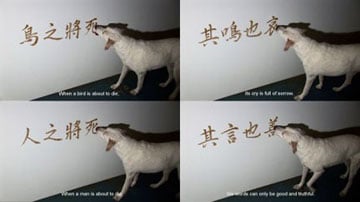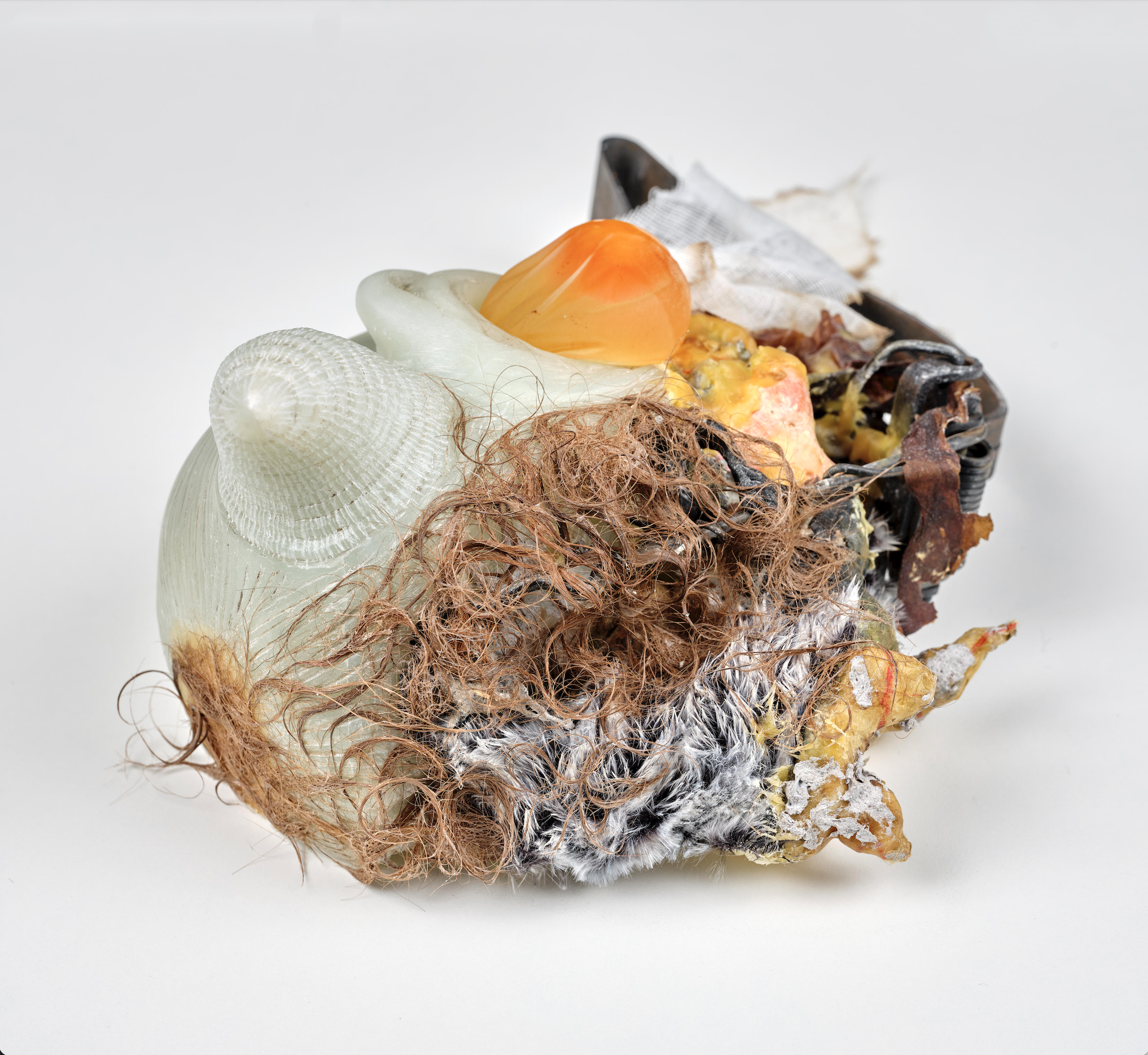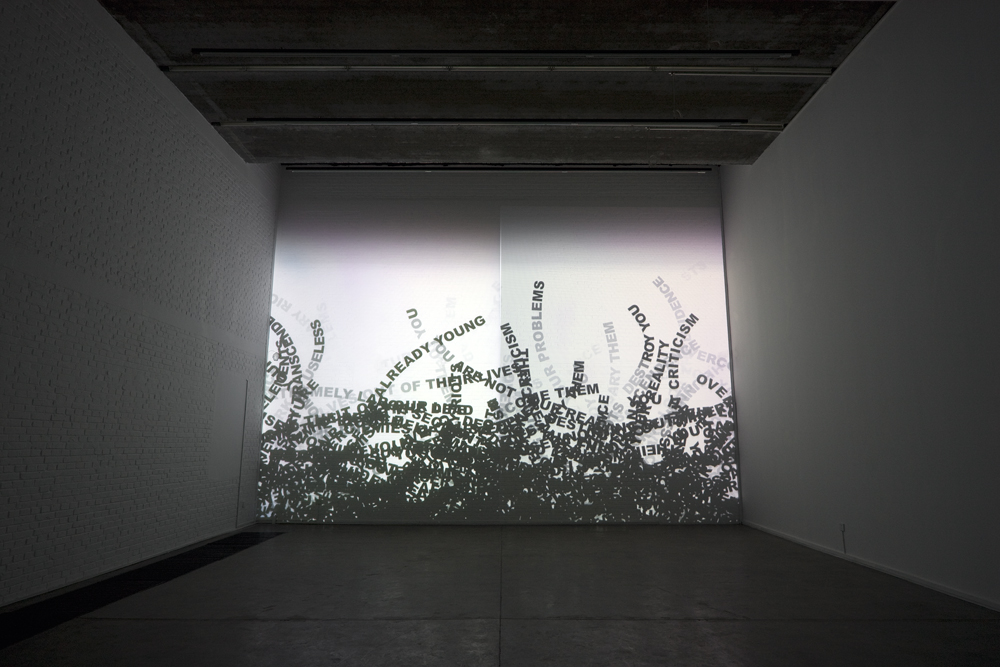
© » KADIST
Hung-Chin Peng
In Excerpts from the Analects of Confucius , Peng Hung-Chih explores the relationship between Confucianism and religion. Specifically, the piece questions the influence of Confucian teachings on the role of the intellectual in contemporary Chinese society. While Confucianism has its own ritual systems and temples, it is not known to be overly concerned with supernatural beings such as gods and demons.

© » KADIST
Catalina Ouyang
font VII by Catalina Ouyang is part of an ongoing series of ‘fonts’, or sculptures, inspired by Catholic holy water vessels. This particular iteration from the series combines hand-carved soapstone, a stop loss trap, horse hair, fermented egg, and other elements to create an artwork that defies categorization. The work’s most notable feature is a small cavity that cradles a naked egg—a translucent, flaccid egg without its outer shell.

© » KADIST
He Xiangyu
He Xiangyu’s Terminal 3 presents excerpts from the lives of young African acrobats attending the Hebei Wuqiao Acrobatic Arts School in China. Acrobatics, which had a rich history as a court display in imperial China, is now integral to the cultural industries and tourism sector in Wuqiao, continuing a legacy of expending bodies for monetary gain. From 2016 to 2019, He intermittently went to Wuqiao Acrobatics School in Hebei Province to record the daily lives of the students who study a variety of acrobatic skills during their year-long program.

© » KADIST
Korakrit Arunanondchai
His untitled paintings express his concern regarding perception in abstract form. Made with bleached denim, stock images of flames and gold leaf, these works embody “human cultures as ghosts.” The gold serves as a reminder of religious paintings, and the denim as emblematic of Western capitalist waste. When describing his paintings, the artist states, “The idea of what Painting is or could be became somehow akin to the image of the earth, as seen from above, from the viewpoint of a drone or a spirit.

© » KADIST
Moe Satt
Hands Around in Yangon is both a secular and religious exploration of the meaning of hands in Myanmar. Moe Satt’s father is Muslim, while his mother is Buddhist. In the Buddhist context, hand gestures or mudras are often important in signifying the identity of deities.

© » KADIST
Ruijun Shen
In Seven Deadly Sins (2006), Shen utilizes abstraction to produce complex topographies of color that evoke associations with violently tumultuous landscapes. Streaks of blue and burgundy paint scatter across a peach colored silk backdrop, dripping into rough floral and botanical forms. At once both diffuse and dense, Shen’s compositions feel both expansive and contained, the colors overlaid atop another with a seemingly free spontaneity that belies more ordered and considered deliberation.

© » KADIST
Khadim Ali & Sher Ali
Drawing & Print (Drawing & Print)
Transaction/Evacuation is a collaborative painting by Khadim Ali and Sher Ali, and is part of a larger collaborative body of works by the artists, which share the same title. Like Khadim Ali, Sher Ali is also part of the Hazara people, and experienced massive personal and social trauma early in life, losing his parents at the age of ten and witnessing the devastation of the Afghan Civil War in his native Kabul. The horned figure in the foreground represents Rustam, a legendary hero in Iranian mythology and central character in the Shahnameh, who depicted here by the artists as a potbellied demon, stripped away of its heroism.

© » KADIST
Yogesh Barve
Global? 1 & 2 documents an annual event during which people of a particular religious group gather around Jejuri in Maharashtra, India. The six-day festival, from the first to sixth lunar day of the bright fortnight of the Hindu month of Margashirsha is celebrated to allow the meeting of the principle God (Khandoba) with other gods carried from different homes of the patrons who take them back at the end of the ceremony.

© » KADIST
Chulayarnnon Siriphol
The single-channel video Myth of Modernity opens on historical representations of the universe in Thai Buddhist places of worship –pagodas, palaces and spirit houses. Denoting three cosmological worlds, the colored religious illustrations and ornate monuments are slowly replaced by images of anti-Yingluck protesters during the 2013-2014 Thai political crisis. Over the masses, a flying neon pyramid –the light sculpture Myth of Modernity – echoes the popular simplification of worship architecture into geometrical shapes.

© » KADIST
Zai Kuning
Drawing & Print (Drawing & Print)
Converting is a piece about the Orang Laut, often called Sea Nomads, that inhabited the Riau archipelago. They were Christians and pagans that were often oppressed by the majority Muslims in the Riau community and were eventually forced to convert to Islam. Zai conveyed this history in Converting through the stark contrasts of red, white, black.

© » KADIST
Tsang Kin-Wah
The Third Seal—They Are Already Old. They Don’t Need To Exist Anymore is part of The Seven Seals , Tsang’s ongoing series of digital videos that are projected as installations onto the walls and ceilings of dark rooms. Using texts and computer technology, the series draws its reference from various sources—the Bible, Judeo-Christian eschatology, existentialism, metaphysics, politics, among others—to articulate the world’s complexity and the dilemmas that people face while approaching “the end of the world.” The Third Seal is a nineteen-by-twenty-seven-foot projection on a single wall that, together with sound, creates an immersive and dynamic environment.
Chulayarnnon Siriphol
Closely associated with the film scene in Thailand, Chulayarnnon Siriphol has also developed a singular approach to film and image making as a visual artist...
Korakrit Arunanondchai
Born in 1986 in Bangkok, Thailand, Korakrit Arunanondchai now lives and works in New York and Bangkok...
Catalina Ouyang
Catalina Ouyang investigates themes of desire, subjugation, and dissidence through object-making, transdisciplinary contexts, and time-based works...
He Xiangyu
Having grown up in China during a period of rapid urbanization and social change, He Xiangyu is especially attentive to the mutability of things and environments...
Moe Satt
Moe Satt is a Burmese visual and performance artist who uses his own body as a symbolic field for exploring self, identity, embodiment, and political resistance...
Tsang Kin-Wah
- location: Hong Kong, China
- year born: 1976
- gender: male
- nationality: Chinese
- home town: Shantou, Guangdong Province, China
Ruijun Shen
Ruijun Shen conceptualizes her painting-based practice as a form of extended meditation and a means of processing tensions between time and space in the world around us...
Zai Kuning
- year born: 1964
- gender: male
- nationality: Singaporean
- home town: Singapore
Hung-Chin Peng
There is a palpable urgency in the work of Taiwan-based Peng Hung-Chih, who uses video, sculpture, installation, and painting as means to criticize society...
Yogesh Barve
Yogesh Barve (b...
Khadim Ali & Sher Ali
Khadim Ali was born in Quetta, Pakistan, after his family fled their home in Afghanistan to escape persecution from the Taliban...
-
2000-2009
Ruijun Shen
2006In Seven Deadly Sins (2006), Shen utilizes abstraction to produce complex topographies of color that evoke associations with violently tumultuous landscapes...
Hung-Chin Peng
2008In Excerpts from the Analects of Confucius , Peng Hung-Chih explores the relationship between Confucianism and religion...
-
2010-2019
Yogesh Barve
2013Global? 1 & 2 documents an annual event during which people of a particular religious group gather around Jejuri in Maharashtra, India...
Khadim Ali & Sher Ali
Drawing & Print
2014(Drawing & Print) Transaction/Evacuation is a collaborative painting by Khadim Ali and Sher Ali, and is part of a larger collaborative body of works by the artists, which share the same title...
Chulayarnnon Siriphol
2014The single-channel video Myth of Modernity opens on historical representations of the universe in Thai Buddhist places of worship –pagodas, palaces and spirit houses...
Zai Kuning
Drawing & Print
2014(Drawing & Print) Converting is a piece about the Orang Laut, often called Sea Nomads, that inhabited the Riau archipelago...
Korakrit Arunanondchai
2017His untitled paintings express his concern regarding perception in abstract form...
He Xiangyu
2019He Xiangyu’s Terminal 3 presents excerpts from the lives of young African acrobats attending the Hebei Wuqiao Acrobatic Arts School in China...
-
2020-2029
Catalina Ouyang
2021font VII by Catalina Ouyang is part of an ongoing series of ‘fonts’, or sculptures, inspired by Catholic holy water vessels...

